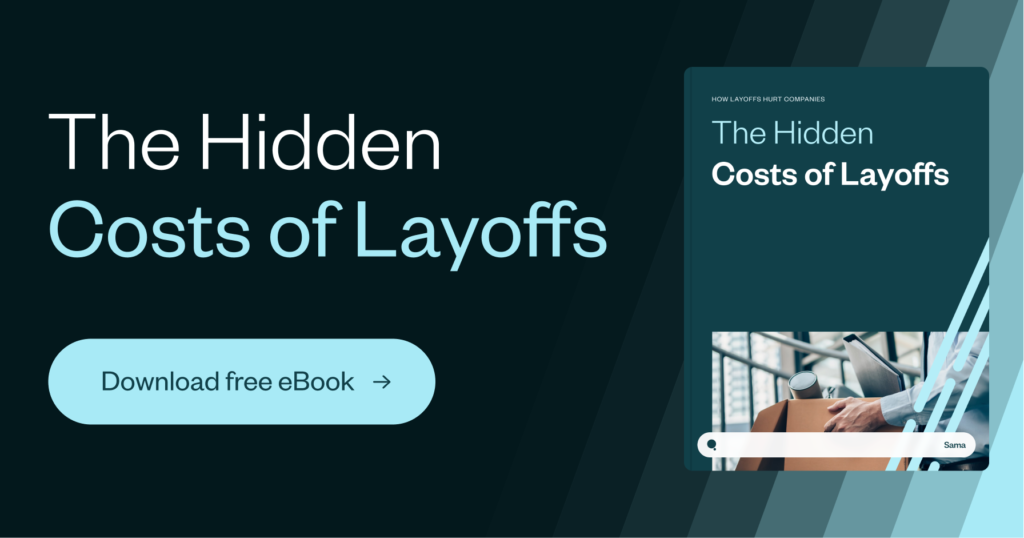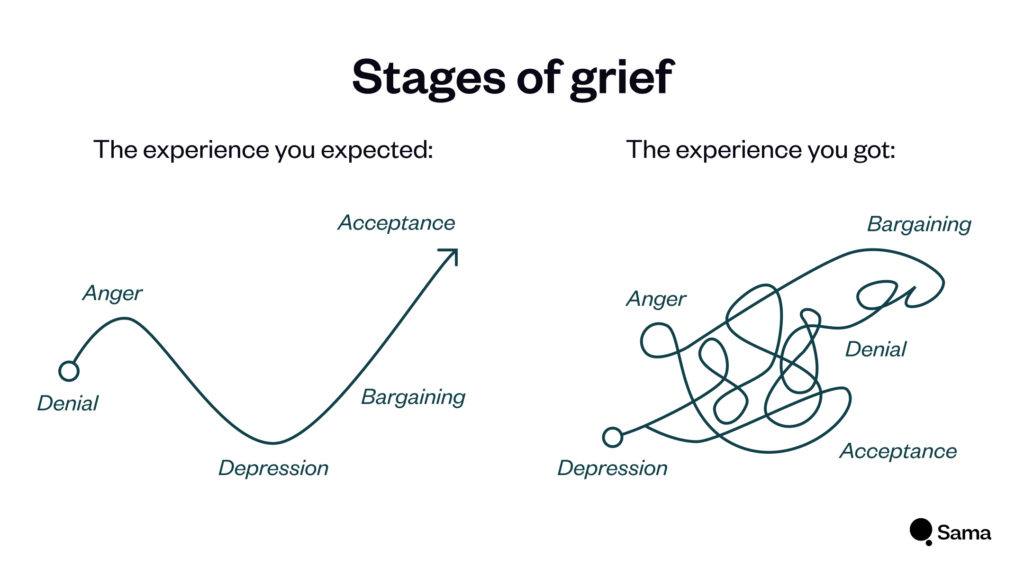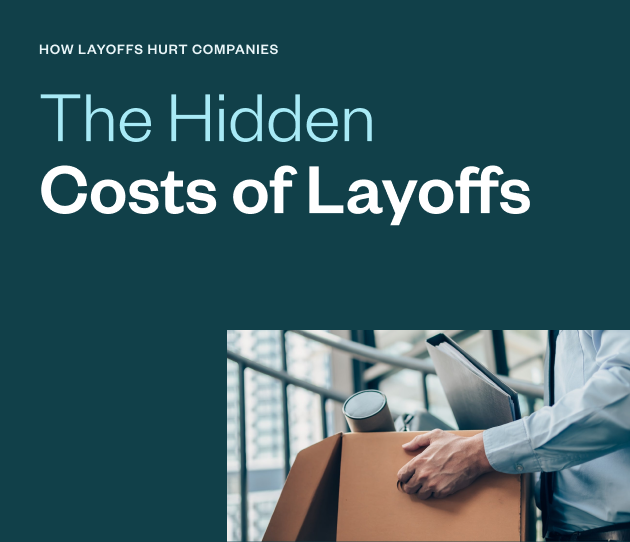Further read
There are few events more disruptive for an organization than layoffs. However well planned, the people remaining in your business feel displaced and disengaged: they’re facing shifting reporting lines, new team dynamics, and changing responsibilities.
The impact layoffs have on exiting employees will – and should be – a huge focus for leadership during this time. Providing support and solutions is paramount. But the huge psychological toll on remaining teams must also be addressed.
Minimizing long term disruption following a round of layoffs is critical to your ongoing success. Avoiding low engagement is the best way to off-set the damages: here are five places to start re-engaging your teams.
- Invest in your leadership
Layoffs bring complex challenges to your leadership team. Whether they’re part of the C-Suite or a first-time manager, developing a solid leadership toolkit benefits not only the individuals, but everyone they interact with.
Critical leadership skills, like clarity of communication and effective delegation, massively reduce the negative impacts of layoffs on your remaining teams. When you engage your team by aligning them with leadership, and help them understand what the new normal looks like, performance will organically improve.
- Avoid ‘burnout culture’
The burden of additional work is disheartening in the wake of layoffs. Your remaining people are picking up ongoing projects, taking on new responsibilities, and trying to achieve more with less.
They’ll feel increased pressure to deliver and appear high-performing due to fear of a second round of layoffs. But the added workload and perceived demand to perform rapidly leads to burnout.
Avoid overloading teams by addressing the risks of burnout head on. Ensure managers are discussing workload and prioritization in 1:1s, create a culture where asking for help is encouraged, and allow people breathing space to adjust to the new way of working.
- Address survivor’s guilt head on
It’s common for remaining teams to experience survivor’s guilt; a complex mix of gratitude that they kept their job, and sadness for their departing colleagues and friends. Unsurprisingly, this anxiety is not conducive to productivity, and output drops by 20% immediately following layoffs.
Be as transparent as you can about the layoffs; understanding the cause, and the criteria, can help eliminate feelings of guilt for departed colleagues.
- Take time to teambuild
After layoffs, team dynamics shift beyond recognition: for people who view workplace relationships as central to their career, layoffs are an enormous blow. Giving teams space to network and socialize allows new bonds to be formed, and people will adjust more quickly.
Consider neurodivergent colleagues, and cultural differences in your team. ‘Team building’ is not just taking your team for Friday drinks; for some, that’s hugely off putting. Team building also looks like:
- Focused creative problem solving
- A 15 minute coffee chat
- Volunteering
- Reinforce your ‘why’
Connecting work with purpose eliminates feelings of uncertainty and gives your people a sense of meaning. Re-centre your company purpose, vision, and values to align teams, and ensure you’re sharing success stories – from new client wins to great internal feedback.
Engage your team by reinforcing company vision and values; reminding everyone what the overarching goal is and what you’re all working towards is sure to inspire your people and gain buy-in.
Layoffs are always complicated. Find out more about the hidden costs of layoffs in our guide

Further read
Employee layoffs are an unfortunate but unavoidable part of the modern business landscape. If you’re reducing headcount, you’re likely buried in compliance and red tape, struggling to find time to prioritize team wellbeing.
We know that being laid off has a significant impact on mental health; it brings setbacks spanning Maslow’s full hierarchy of needs. In addition to lost income, it means saying goodbye to status, structure, and a feeling of security.
As with any major loss, people you’re letting go will experience the five stages of grief, cycling through a number of challenging emotions. Minimizing the impact on mental health sounds arduous, but there are some simple steps you can take to support your team.
How does grief show up in layoffs?

While Kubler-Ross’ model of grief (left) shows a process, many people experience a more erratic, fluctuating emotional response to redundancy (right). But the emotions involved remain the same. It’s crucial to understand how to appropriately support people you’re letting go through each of them.
“There’s been a mistake!” People generally start with denial, struggling to process the news and accept the reality of their situation, prolonging their suffering. Minimize room for denial with clear, concise communication, so everybody knows where they stand: what’s happening right now, and what the next steps are.
Anger presents in many forms – from directing resentment at employers to taking out frustrations on family. It’s commonly associated with a sense of abandonment; you should support leavers with personalized solutions, including career coaching to minimize feelings of injustice.
Some employees may search for ways they can stay in the business, and cause themselves great distress bargaining. Provide clarity on the reality of the situation to mitigate negative impacts on self-worth.
As reality sinks in, depression often hits. Many feel a sense of despair and anxiety, becoming demotivated and making it harder to find a new role. Access to mental health support minimizes harm, and coaching helps employees gain perspective and reassess their situation.
Eventually, everybody reaches acceptance, ready to take their next steps. Help people get there faster by providing wider outplacement support. Create a bank of resources, like CV writing tips and career planning webinars, to demonstrate options.
The impact of outplacement on employee layoffs?
Outplacement programs provide holistic, people-focused support for everyone within your organization – whether they’re leaving or staying. They differ between companies, but are aligned in their goal to minimize the potential impacts of redundancies and employee layoffs.
Outplacement includes:
- One-on-one and team coaching
- Career coaching
- CV-building workshops
- Interview training
- Skills assessment
- Job search assistance
Outplacement support transforms a traditionally daunting experience into one that is empowering for you and your employees. Sama coaching focuses on building resilience and helping people get back on track for their goals.
Grief management is critical to protecting everybody involved in a layoff cycle: make sure it’s top of your to-do list before layoffs begin.

Further read
If you’re considering making layoffs, you’re not alone. Recent news has been peppered with stories of huge brands downsizing due to changing markets and global conditions.
For business leaders and HR teams, managing redundancies is one of the toughest things you’ll face in your career. Not only is there the emotional burden of letting people go, there’s also anxiety around the long-term impact of reducing headcount.
Providing support to exiting team members helps ease the burden. But how can you ensure you’re doing enough to protect your remaining teams? In this blog we’ll help you understand why building resilience in your teams is key to ongoing business success, and how to develop those all important skills.
The emotional toll of layoffs
Surviving a round of layoffs can be bittersweet. Staying employed in an uncertain economy is clearly a positive, but not only does it raise concerns around the company’s future, many remaining employees feel guilty about their recently departed friends and colleagues.
Known as survivor’s guilt, this emotional response manifests in a number of ways that can be detrimental to business. From low morale impacting productivity, to anxiety causing employees to consider careers elsewhere, and a heightened risk of burnout, your ‘survivors’ need the right support to drive success in the wake of layoffs.
The risk to productivity
Remaining teams experience a 20% decline in productivity – at a time when you really need people to be performing. This is largely due to uncertainty around their ongoing job security, and the ripple effect of shifting reporting lines and team dynamics.
Innovation also takes a huge hit. Reducing headcount means losing creativity and diversity of thought; firms that cut their staff by 15% see a 24% decline in the number of new inventions.
The power of resilience
Resilience is not a lack of emotional response. It is actually the ability to withstand or recover quickly from challenges.
While there’s no getting away from the emotional toll of layoffs, resilient employees are more equipped to process their emotions, and remain dedicated to their work, even in the face of setbacks.
Resilience has a positive impact on engagement and overall wellbeing. Nurturing resilience in your employees helps you create an environment less impacted by change; remaining employees are more productive and engaged, ultimately protecting your bottom line.
How can you boost resilience in your employees?
Working one on one with a coach gives employees the space to understand how to process their emotions and overcome roadblocks: they’ll develop essential skills needed to thrive during adversity.
The best coaches empower employees to self-discover pre-existing skills, work on new ones, and develop self-awareness – enabling clarity of thought and constructive responses to challenges.
Change is inevitable. Whether or not you’re reducing headcount, investing in your team’s resilience future-proofs your success. Building resilient teams who know how to recover from setbacks and take adversity in their stride is good for business.
Find out more about ways to support your whole business through layoffs with out guide: The hidden costs of layoffs.






